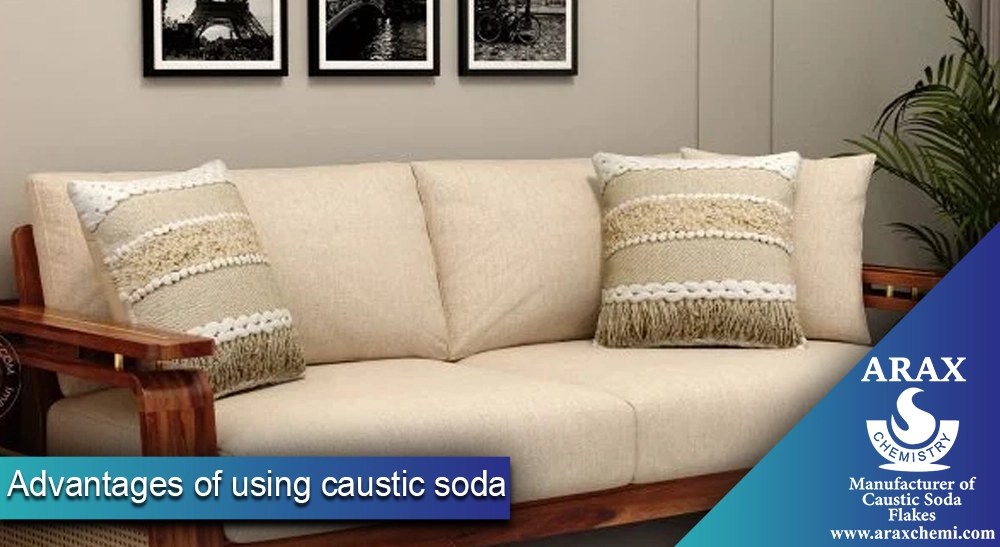Caustic soda, also known by its chemical name sodium hydroxide, is one of the most widely used chemicals in various industries. With its unique properties, including high cleaning power and reactivity, it is utilized in numerous industrial processes. One of the industries that benefits from caustic soda is furniture making. Furniture making, which is known for the art of turning wood and other raw materials into beautiful pieces of interior decoration, requires precise and effective processes that can guarantee the final quality of the products. In this article, we will explore the various applications of caustic soda in furniture making, from initial wood processing to cleaning and maintaining furniture. We will also examine the advantages and disadvantages of using this chemical and the safety precautions associated with it to provide a comprehensive view of the critical role of Caustic Soda in the Furniture Industry
Wood Processing Using Caustic Soda
Caustic Soda in the Furniture Industry, one of the important and initial stages is wood processing, which significantly affects the final product’s quality and durability. Caustic soda plays a key role in this process as a powerful and effective chemical.
Removing Old Layers of Paint and Varnish
One of the primary applications of Caustic Soda in the Furniture Industry and wood processing is the removal of old layers of paint and varnish from the wood surface. With its strong alkaline property, this substance can easily decompose and separate paint and varnish compounds from the wood surface. This process helps prepare the wood for subsequent stages such as sanding, repainting, and applying new varnishes.
Cleaning and Preparing the Wood Surface
Caustic Soda in the Furniture Industry is also used in cleaning and preparing the wood surface for further furniture-making processes. This substance can remove contaminants, oils, and other waste materials from the wood surface, preparing it for subsequent steps like painting and final finishing. This deep cleaning ensures that paints and varnishes are evenly and effectively applied to the wood surface, resulting in a high-quality finish.

Wood Preparation Processes
For using caustic soda in wood processing, a solution of this substance with water is usually prepared. This solution is applied to the wood surface using a brush or spray. After the solution has adequately affected the wood, the wood surface is washed and cleaned with water to remove residues of caustic soda and decomposed materials. This stage requires precision and attention to prevent damage to the wood texture.
Cleaning and Disinfecting with Caustic Soda
Maintaining the cleanliness and disinfection of tools and equipment is of high importance in the furniture industry. Caustic Soda in the Furniture Industry, with its unique properties, plays a significant role in these processes.
Cleaning Tools and Equipment
Caustic Soda in the Furniture Industry, as a strong alkaline substance, can effectively remove oils, grease, and other contaminants from tool and equipment surfaces. With its decomposing property, it quickly dissolves organic materials, resulting in deep and effective cleaning. Tools like saws, drills, and woodworking machinery that are in direct contact with wood and other materials require regular and thorough cleaning. Caustic soda can easily eliminate these contaminants, preparing the tools for reuse.
Disinfecting Surfaces and Equipment
Another important application of caustic soda in furniture making is disinfecting surfaces and equipment. With its strong alkaline property, this substance can effectively kill bacteria, fungi, and other harmful microorganisms. Disinfecting tools and equipment not only helps maintain the health of workers but also prevents contamination of the final products. Caustic soda can be used as a powerful disinfectant in sanitation and cleaning programs in various industries.
Disinfecting Furniture with Caustic Soda
For using caustic soda in cleaning and disinfecting, a solution of this substance with water is first prepared. Depending on the need and the level of contamination, this solution can be prepared at different concentrations. The caustic soda solution is usually applied to surfaces and equipment using a brush, sponge, or spray. After the solution has adequately taken effect, the surfaces are washed and cleaned with water to remove residues of caustic soda and decomposed materials.
Industrial Processes in Furniture Production
Caustic Soda in the Furniture Industry plays an important role in various industrial processes, including furniture making, in producing raw materials and the necessary chemicals. Some of the industrial processes in which caustic soda is used include:

Resin and Adhesive Production
Resins and adhesives are essential materials in furniture making, used to bond different parts and create strength and durability in furniture. Caustic soda is used in the production of phenolic and epoxy resins as a catalyst and pH regulator.
Industrial Cleaning Agent Production
Due to its strong alkaline property, caustic soda is used in producing industrial cleaning agents and degreasers. These materials are used for cleaning equipment and tools used in furniture making.
Material Purification and Recycling
In industrial production processes, caustic soda is used for purifying and recycling waste materials and byproducts. This substance can help separate and recover useful materials from waste.
Advantages of Using Caustic Soda
High Cleaning Power
Due to its strong alkaline property, caustic soda has a high capability in removing contaminants, oils, and layers of paint and varnish. This feature makes it an effective material in cleaning and preparing wooden surfaces.
Efficiency in Disinfection
With its ability to kill microorganisms, caustic soda is used as a powerful disinfectant in various industries, including furniture making.

Cost-Effective
Due to its reasonable price and availability, caustic soda is recognized as a widely used and cost-effective chemical in various industries.
Disadvantages of Using Caustic Soda
Health Hazards
Caustic soda, due to its strong alkaline properties, can cause harm to the skin, eyes, and respiratory system. Contact with this substance can lead to severe burns and serious injuries.
Environmental Risks
Improper disposal of caustic soda and its waste can harm the environment. Therefore, proper management of chemical waste and adherence to environmental regulations are essential.
Dangerous Chemical Reactions
Caustic soda can cause dangerous and severe reactions if it comes into contact with certain other chemicals, such as acids. This necessitates high caution and precision in its use and storage.
Safety Precautions in Using Caustic Soda
Using Caustic Soda in the Furniture Industry requires adherence to specific safety precautions. This substance is highly alkaline and can harm the skin and eyes. Therefore, wearing resistant gloves, protective goggles, and appropriate clothing is necessary. Proper ventilation in the work environment is also essential to prevent inhalation of harmful vapors. After completing the work, all tools and equipment should be thoroughly washed and cleaned.
Conclusion
Caustic Soda in the Furniture Industry, as a widely used chemical in the furniture industry, has its own advantages and disadvantages. With its high cleaning and disinfecting power, it is utilized in various processes of production, cleaning, and maintenance of furniture. However, using caustic soda requires strict adherence to safety precautions and proper management of its waste. By using this substance correctly and responsibly, it is possible to enhance the quality and durability of furniture products while preventing potential hazards.

